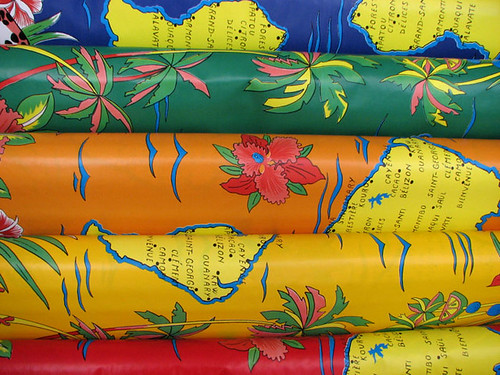By Nicholas Laughlin
Sheets of linoleum printed with maps of French Guiana, on sale in Cayenne. Photo by Nicholas Laughlin; 8 April, 2009
[Excerpted and adapted from “Guiana Dreams”, an essay written for the Paramaribo SPAN catalogue. Read the full version here.]
Every place on earth is haunted by stereotypes. But some are more haunted than others, and some places are more tenaciously bound by the metaphors and fictions spun around them.
For the better part of five centuries, the region of South America that we call the Guianas has been tethered in the imagination of the West as a geography to be explored and exploited, endured and adventured in, but not as a place to truly make a home. The Dutch and the English built plantations and ports in their Guiana colonies. The French built prisons. Desired raw materials were shipped out, and undesirable men shipped in. That societies evolved here — hybrid communities where cultural elements from four continents collide and collude — was an accident of history.
Now we find ourselves in what we like to call a postcolonial age, having exchanged flags in a series of midnight ceremonies over the past forty years. But capital-I Independence has not made us less reliant on global economies, whether of finance, trade, or ideas. We depend as much as ever on foreign dollars and attention. And the world’s regard still filters through a persistent swaddle of stories we did not tell, images we did not make.
The predicament might be summarised in a question quoted by the literary scholar Mary Louise Pratt, in Imperial Eyes, her study of the ways travel literature has portrayed Latin America and Africa for European readers. How does “a destination for others” — a place that has been described and depicted mostly by others from elsewhere, with their own missions and prejudices — a place like Suriname, like the Caribbean — become “a home for the self”, for the real women and men who are born here, raise families, and work to achieve safe and comfortable lives? This big question touches on matters of political self-determination, cultural self-assertion, personal self-comprehension, and is specially urgent for those — our artists, our writers — whose labour it is to imagine new stories to replace the old ones that have trapped us.
Sign welcoming visitors to Lethem, Guyana, on the border with Brazil. Photo by Nicholas Laughlin; 7 August, 2005
Artists everywhere grapple with doubts about relevance and audience and income. But in Suriname, in the Caribbean, the smallness of our societies intensifies the struggle. The artist’s options can appear vexing. Fall back on local social networks offering patronage and flattery? Adopt the vocabulary and gestures currently fashionable in foreign academies, and try to catch the eye of a visiting curator? Resort to approved motifs of ancestral heritage and play the role of the “intuitive” or “primitive”, hoping to be recognised as authentically exotic?
Initiatives like ArtRoPa, arranging working exchanges between artists in Suriname and the Netherlands — or like the Wakaman Project, instigating creative partnerships between Surinamese artists at home and abroad — or like Paramaribo SPAN, building a platform to share the work of artists in Suriname with audiences elsewhere — seem to offer the possibility of stepping past the limits of a small place, the chance to infiltrate the wider world with our own metaphors and hopes. But, inevitably, old fictions intervene, and artists often find themselves and their audiences snarled in preconceptions of what Surinamese (or Caribbean) art should look like, what its acceptable subjects might be, how it should “read”, what it could mean.
An artist’s job is to create something meaningful — an object, an experience, a sensation — in the space where personal vision and ambition meet opportunity and social circumstance. The dimensions of that space are constantly shifting, and one way to define an artist’s success is by the range of the creative territory he or she is able to inhabit. For artists from parts of the world that have long been “destinations for others”, the space of potential action, and the ways their work can be received and understood, are bounded by the old imaginary geography. Before we can cross that boundary — or shift it, or erase it — we must both see it and recognise it for what it is: a confining fantasy of the exotic with a long history and a heady allure.
Metaphors have alarming longevity. The New World, five centuries later, is still “new”. To kill a story requires a more powerful story, a more resonant fiction. And re-charting the domain of our hopes and fears — our creative space, our “home for the self” — whether we give that home the name of a nation or a region, Suriname, Guiana, the Caribbean — demands immense and sustained feats of imagination. It demands that we invent new images and new languages to describe and debate our own real world, its scope and its span. It demands powerful and resonant new dreams.
Patriotic footwear, Paramaribo. Photo by Nicholas Laughlin; 29 June, 2009
Reading: on stereotypes, metaphors, and dreams
Wednesday, January 27, 2010
Subscribe to:
Post Comments (Atom)






0 comments:
Post a Comment